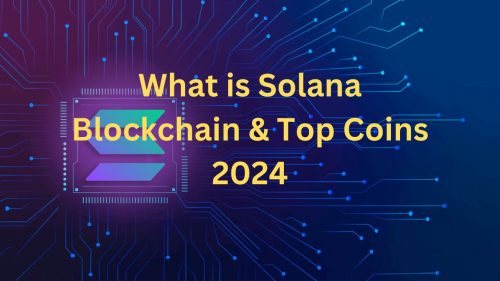Solana is a cutting-edge blockchain network renowned for its support of decentralized applications (dApps) and smart contracts. The platform’s primary cryptocurrency is SOL, complemented by over 400 other tokens and coins native to the Solana ecosystem. This article delves into the Solana blockchain and highlights some prominent tokens operating on it.
The Solana Blockchain
Launched by Solana Labs in 2020, Solana offers a high-performance alternative to other blockchains like Ethereum. It employs a unique hybrid consensus model called Proof of History (PoH) combined with Proof of Stake (PoS) to deliver rapid transaction speeds and minimal costs.
Distinctive Features of Solana
Solana’s standout attributes include:
- Ultra-fast transaction speeds: Capable of processing over 60,000 transactions per second (TPS), Solana is among the fastest blockchains globally.
- Minimal fees: Transaction costs are exceptionally low, often just a fraction of a cent, significantly cheaper than Ethereum’s gas fees.
- Quick block times: With new blocks generated every 400 milliseconds, confirmation times are swift.
- Scalability: Solana can scale horizontally, leveraging GPU and SSD technology.
- Smart contract support: Developers can create dApps and deploy smart contracts, facilitating a variety of DeFi solutions.
Solana’s Consensus Mechanism
Solana’s PoH mechanism cryptographically verifies time between events, providing a historical record that helps the network achieve consensus on transaction order. This enables parallel processing of transactions, enhancing speed.
Native Tokens on Solana
Over 400 tokens and coins are built on Solana, with the primary asset being the SOL token. Additionally, many SPL tokens operate within this ecosystem.
The SOL Token
SOL is integral to the Solana network, serving several key functions:
- Network security through staking: SOL holders can stake tokens to help validate transactions.
- Transaction fees: SOL is used to cover transaction and smart contract interaction fees.
- Governance: SOL holders can vote on network upgrades and proposals.
- Incentives for validators: Validators earn SOL as rewards for securing the network and processing transactions.
SOL Tokenomics
SOL has a maximum supply of 511 million tokens, with new tokens minted as block rewards for validators. The inflation rate is dynamic, adjusting based on the percentage of tokens staked.
SPL Tokens
Developers can create SPL tokens on Solana with ease. SPL (Solana Programming Library) tokens encompass various assets like coins, NFTs, and stablecoins.
Popular SPL Tokens
Notable SPL tokens by market cap include:
- Serum (SRM): Utility token for the Serum decentralized exchange (DEX).
- Raydium (RAY): Governance token for the Raydium DEX.
- Bonfida (FIDA): Used for fees and governance on Bonfida DEX.
- STEP (STEP): Utility token for the fitness app Step App.
- Saber (SBR): Native token for the cross-chain stable swap platform Saber.
Comparing Solana to Other Cryptocurrencies
Solana offers distinct advantages over other blockchain platforms like Ethereum and Cardano, particularly in terms of speed, costs, and developer experience.
Solana vs. Ethereum
- Speed: Solana handles 60,000 TPS, far exceeding Ethereum’s 15 TPS (or 100 TPS post-upgrades).
- Fees: Solana’s transaction fees average around $0.00025, significantly lower than Ethereum’s $2-10.
- Smart Contract Capabilities: While Ethereum has a lead in smart contract development, Solana is gaining traction due to its speed and cost benefits. Additionally, Solana offers Ethereum compatibility through the Wormhole bridge.
Solana vs. Cardano
- Development Activity: Solana’s ecosystem has rapidly expanded to over 400 projects across DeFi, NFTs, and Web3, while Cardano has seen slower growth since its smart contract capabilities were introduced in 2021.
- Decentralization: Solana has faced criticism for its less decentralized, permissioned validator model, though it aims to improve decentralization over time. In contrast, Cardano emphasizes decentralization through its PoS consensus.
Building dApps on Solana
For developers, Solana offers several advantages:
- Cost: Building on Solana is cheaper, with lower transaction fees and less network congestion.
- Speed: Fast transaction speeds enhance the user experience.
- Programming Languages: Solana supports popular languages like Rust and C++, lowering barriers for developers.
Investing in Solana Coins
The SOL token and other Solana-based coins offer investors exposure to the rapidly growing Solana ecosystem.
SOL Price Analysis
- Historical Performance: SOL has seen remarkable growth, increasing over 11,900% from $1.84 at launch to $220 at its peak in November 2021.
- Price Prediction: Analysts predict SOL could reach $250 to $500, driven by growing adoption, though it remains a speculative investment.
Risks and Challenges
Solana faces challenges related to decentralization, security, competition, and market volatility, which pose risks for investors.
Storing and Trading Solana Coins
Solana coins can be stored and traded using several platforms:
- Wallets: Popular wallets include Phantom (a browser extension) and Solflare (a mobile wallet). Hardware wallets like Ledger also support Solana.
- Exchanges: Major exchanges like Kucoin and Binance offer SOL and other Solana-based assets.
Conclusion
Solana’s high speed, scalability, and low fees are attracting developers and investors alike. Despite concerns about decentralization, Solana is establishing itself as a formidable platform for next-generation blockchain applications.
